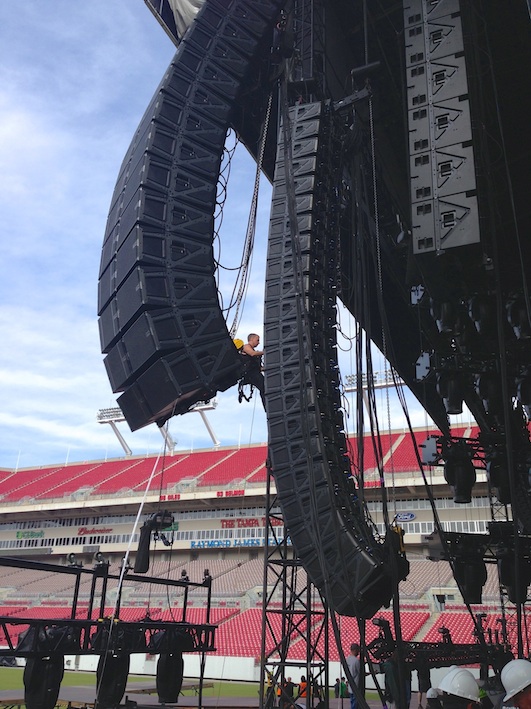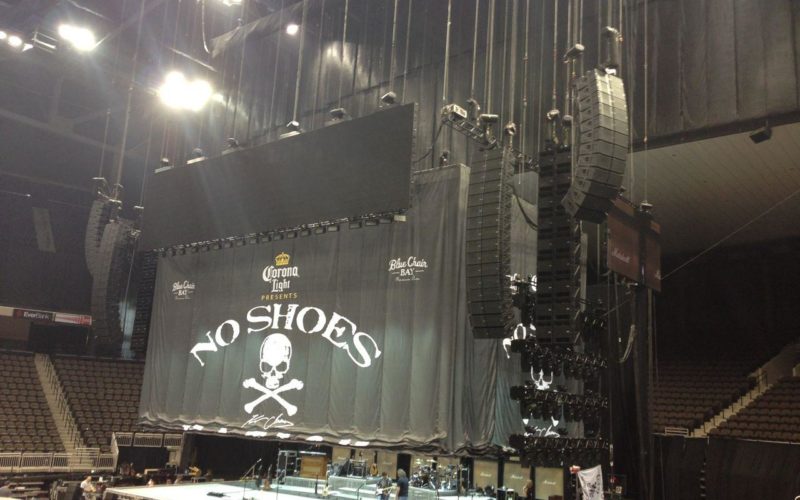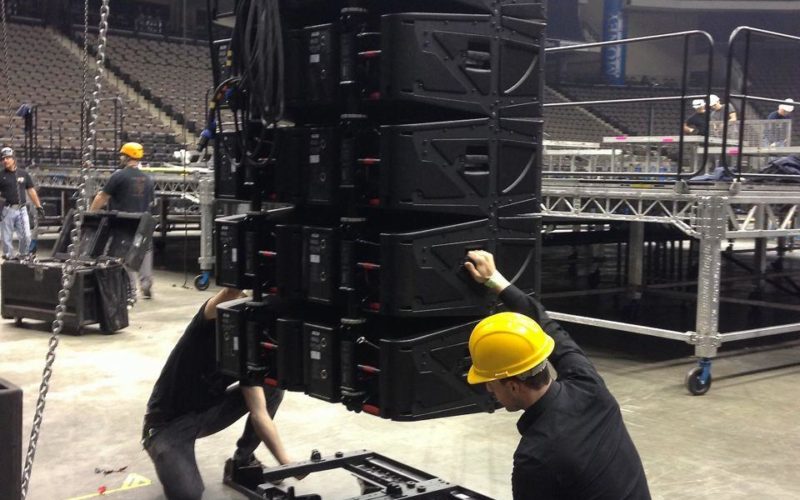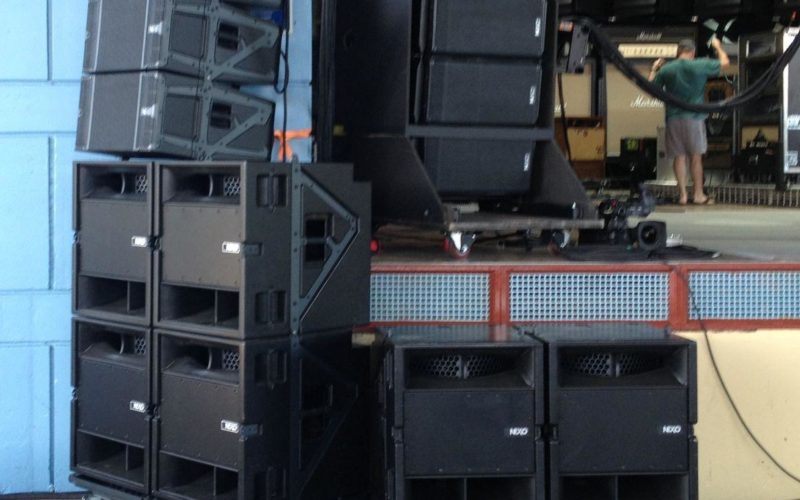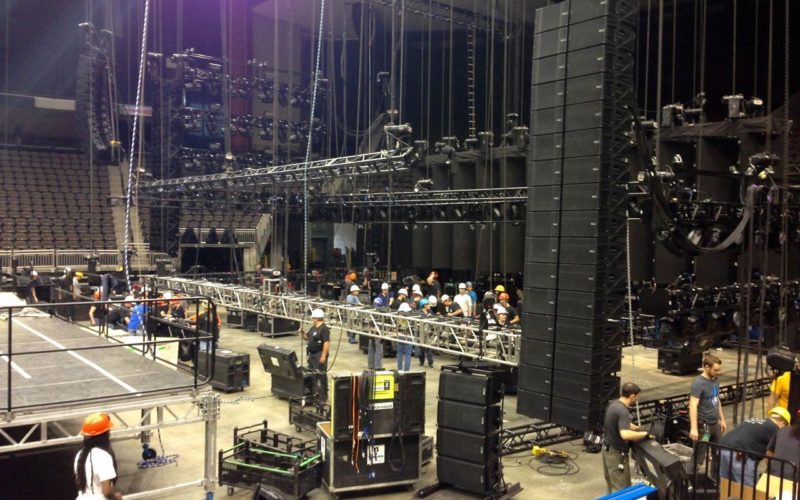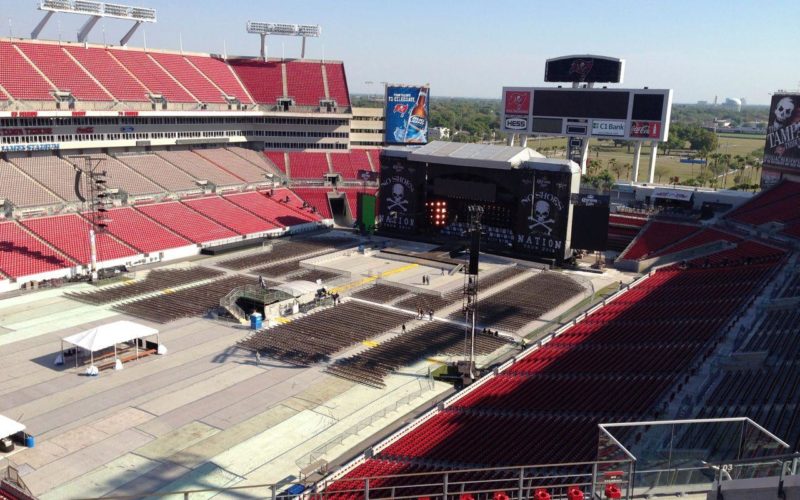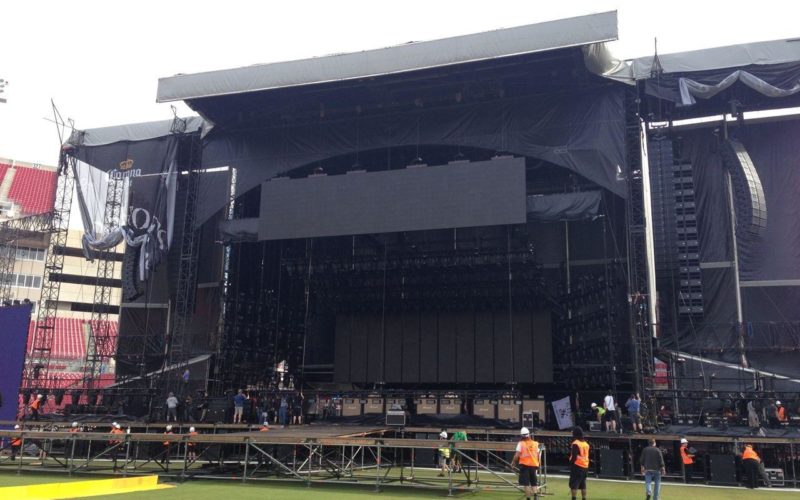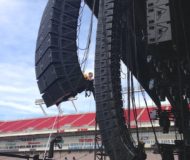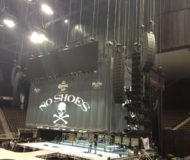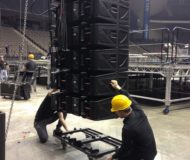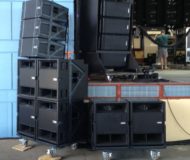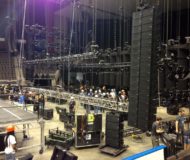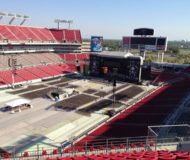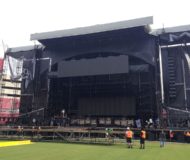Morris Light & Sound was an early adopter, joining the development process of the new NEXO System. “We were involved with the STM system for about a year before the system launched,” states John Mills, Morris VP and systems engineer for the Chesney tour. “Since we were the first company with a system of this size, Chris Rabold (Chesney FOH engineer) and I provided NEXO with tons of input on how it was performing and what we were doing with it from a tuning perspective.”
Mills said the support from NEXO was unparalleled. “We had at least one programmer and one system specialist with us for the first few weeks of rehearsals and shows. Beyond that, we sent them our tuning files and SMAART measurements and they incorporated our preferences into a new preset. Since then we honestly do very little to the PA each day. From stadium to shed, 70,000 seats to 10,000 seats, our tuning is almost always the same. The consistency and accuracy of the PA is like none I have ever tech’ed. From what my NS1 model predicts to what we measure is really the best software/hardware/measurement relationship I have ever experienced. It really makes my job as a system engineer easier because it is so accurate.”
One of the first things that attracted Morris Light & Sound to the NEXO STM, Mills continued, was the modularity. “It really works; we have done large and small venues and even some small ground stacked systems. It is great to have a system that sounds the same no matter how you deploy it.
“The modularity and scale-ability coupled with the accuracy are second to none. Sonically, the throw of the system out performs anything on the market. Vocals, guitars, and even high-hat and cymbals are still clear and musical at 400 feet away. It is very accurate and revealing. Very small moves in the system EQ are very noticeable. STM was everything I hoped it would be, and more.”
“From the first meeting we had with NEXO discussing the concept of the STM, I was very intrigued,” states Morris L&S President, David Haskell. “Then, after subsequent meetings, trips to the factory, and getting to better understand both the product and the people behind it, I am proud to say that this relationship with NEXO has been amazing. From concept drawings to manufacturing and implementation to ongoing support, the STM and the fine folks behind it can only be summed up in one word…flawless!”
“This is our first major tour with STM. For stadium and arena systems, we have main and side hangs and, currently, we always pair an M46 main cabinet with a B112 bass cabinet. STM does give us the option of moving the side hang B112 to the front to make the main hang a triple wide [B-M-B, the ‘double-bass’ configuration], leaving the side hang as just a single-wide M46, and we are considering trying that on next year’s tour. But for now, the system is working really well with both hangs configured as M46/B112.”
Stadium
Mains 22 Deep
Sides 15 Deep
Air Subs Flown 12 Deep double wide S118
Ground Subs 4 stacks (per side) 2 tall RS118 in cardioid mode
front fill (per side) 5 PS10R2
ground stack out fill (4 Geo S1210) per side
* John Mills adds, “For some of the taller stadiums, we extend to 20 and 17 on the mains.”
Arena
Mains 16 Deep
Sides 12 Deep
Air Subs Flown 8 Deep double wide S118
Ground Subs 3 stacks (per side) 2 tall RS118 in cardioid mode
front fill (per side) 4 PS10R2
Shed/Amphitheater
Mains 16 Deep
Sides ground stack out fill (4 GEO S1210) per side
Air Subs Flown 8 Deep double wide S118
Ground Subs 2 stacks (per side) 2 tall RS118 in omni mode.
front fill (per side) 2 PS10R2
center fill 1 per side Geo S1230 firing from under the array into the center front section of seats.
* “Most of the sheds have a cement stage so we take advantage of the quarter space loading of the subs next to the stage, where a cardioid solution just takes up too much valuable real estate,” explains John.
* “Kenny does not like lip fill speakers as he wants a very clean stage… so we use the control and power of the GEO S1230 for hitting the front rows from the side wings.”
THE VIEW FROM FRONT OF HOUSE
The man in front of the console is Chris Rabold. NEXO caught up with him in Anaheim to ask a few questions about using the STM in different configurations.
When asked how the STM sounds to him, Chris said the system sounded hi-fi and clean. “Even when I drive it hard, it won’t distort. My ears have yet to feel fatigued after a show; that’s indicative of a clean system. On a mixing level, I’m getting some great sounds. There was a bit of a learning curve in the beginning as was to be expected. I have a specific sound that I want to achieve everyday. Once I learned what the NEXO STM wanted to do naturally, I married that with my own goals and we’ve been in great shape ever since. John Mills and NEXO obviously had a good line of communication by the time I arrived on the tour, and they were extremely proactive with any of our suggestions early on.”It’s just incredibly un-coloured. That was pretty much my initial reaction. I definitely had to add character, because it was void of it, which is good, which I like!
“I usually have more of an upward slope in the PA tonality, starting in the mid-range, but because this is so flat in that area, I do things slightly differently. To put it simply, what I want to hear is what I hear, and when I reference in my headphones, that are the same I use on any show, any PA, it translates really well. What I put in is what I get out, and if the inputs are good, I barely use any EQ. Again, that’s a good thing!
“It’s hard to give you a detailed explanation of how things translate over the different formats, because the smallest show we’ve done is 12 boxes on the main hangs. I’ve yet to do 8 or 6. What I can say, is so far whatever we’ve done, from 12 to 20 or so boxes, it’s very consistent, and that’s what I look for.
“I can tell you this: when I tune the 20 box rig, I do something that I do when I believe a system is consistent, which is to take my EQ from the mains and copy it over to the sides, with the hope that even if the side is a smaller array, say 16 or 14, it will translate well, and it typically does. All I’ll do on the side hang is take a little more low out because I’ll have quite a bit coming off the larger mains.
On the 12 box hang it did behave differently, hard to say what, but I remember saying to myself: “It’s a smaller rig, it’s not coupling in some areas”, which is normal, but I’m really curious, I really am, I’d love to do an 8 box show, just to see, or say an 8 box show with no air-subs. I think that would be fun.”
Live Sound International magazine has published a feature on the Kenny Chesney tour; you can see it here in their digital edition.
http://digital.livesoundint.com/publication/?i=168785&p=22
For further information:
Morris Light and Sound Inc.
www.MorrisLightAndSound.com














































